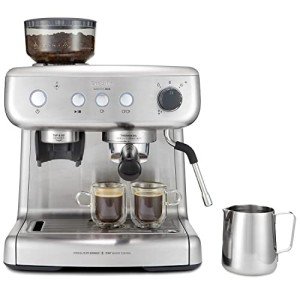The Main Issue With High-Quality Espresso Machines, And How You Can Fix It

The World of High-Quality Espresso Machines: A Comprehensive Guide
Espresso has become a cherished beverage amongst coffee lovers worldwide, known for its abundant taste, intense aroma, and adaptability. The heart of a terrific espresso lies in the machine used to brew it. High-quality espresso machines are developed to provide the ideal shot, making them an important financial investment for coffee enthusiasts. This article explores numerous kinds of high-quality espresso machines, their features, upkeep pointers, and answers to frequently asked questions.
Kinds Of High-Quality Espresso Machines
High-quality espresso machines fall under several categories, accommodating different preferences, skill levels, and budget plans. The primary types include:
| Type of Machine | Description | Ideal User |
|---|---|---|
| Manual Espresso Machines | Needs user skill to control extraction and pressure. Uses the most control over the brewing procedure. | Experienced baristas and enthusiasts |
| Semi-Automatic Machines | Integrates manual operation with automation. informative post control the grind and tamping, while the machine deals with water dispersion. | Intermediate users |
| Automatic Espresso Machines | Automate the brewing process, allowing for programmable brewing times and temperature levels. | Casual coffee drinkers |
| Super-Automatic Machines | Have integrated grinders and are completely automated, handling whatever from grinding to brewing and steaming. | Users looking for convenience |
| Commercial Espresso Machines | Developed for high volume use in coffee shops and restaurants, offering durability and speed. | Entrepreneur |
Detailed Overview of Each Type
Manual Espresso Machines
- Pros: Complete control over the brewing process; can produce exceptional quality espresso.
- Cons: Requires considerable skill; time-consuming.
Semi-Automatic Machines
- Pros: Balanced control, mixing manual and automatic procedures; superior quality espresso is still achievable.
- Cons: Requires some understanding and experience to master.
Automatic Espresso Machines
- Pros: User-friendly; minimizes the learning curve while still producing high-quality espresso.
- Cons: Still requires some understanding of coffee-making fundamentals.
Super-Automatic Machines
- Pros: Maximal benefit; little skill required; ideal for people or households who desire coffee without hassle.
- Cons: Higher cost point; may do not have the fine-tuning abilities of manual machines.
Commercial Espresso Machines
- Pros: Built for durability and performance; often consists of features for high-volume turns.
- Cons: Expensive; may be overkill for home use.
Secret Features to Consider
When looking for a high-quality espresso machine, several essential functions ought to be taken into consideration:
- Pressure and Pump Type: Look for machines with at least 9 bars of pressure, which is important for drawing out the very best flavor from coffee beans.
- Boiler Type: Single, double, and heat exchanger boilers each affect how the machine carries out and the speed of developing.
- Build Quality: High-quality materials such as stainless-steel are more suitable for sturdiness and visual appeals.
- Ease of Use and Cleaning: Some machines need substantial cleaning, while others are designed for easy upkeep.
- Temperature Control: Consistent temperature is critical; think about machines with PID controllers for accurate control.
Benefits of High-Quality Espresso Machines
Investing in a high-quality espresso machine provides a wide range of advantages:
- Superior Quality: High-end machines enable greater control, causing more delicious espresso.
- Durability: Built to last, quality machines require fewer repair work and replacements.
- Modification: Users can enjoy a customized experience by adjusting grind size, shot timing, and other settings.
- Increased Convenience: Automatic and super-automatic choices allow fanatics to enjoy espresso with minimal effort.
Upkeep and Care for High-Quality Espresso Machines
To keep an espresso machine operating optimally, routine maintenance is vital. Here are pointers for maintaining a high-quality espresso machine:
Descale Regularly:
- Use a descaling solution every few months to prevent buildup of minerals from water, which can impact taste and performance.
Clean the Brew Group:
- For machines with a detachable brew group, clean it regularly to make sure a clean extraction.
Change Water Filters:
- Use a water filter and change it as required to decrease pollutants in your developing water.
Daily Cleanings:
- Rinse the portafilter and group head after each use to avoid oil buildup.
Keep an Eye on the Parts:
- Monitor seals, gaskets, and other parts for wear and tear and change them as required.
Often Asked Questions (FAQs)
1. What is the best espresso machine for novices?
For beginners, a semi-automatic machine often supplies a great balance of use and control, allowing users to learn the skills needed for making excellent espresso.
2. Are super-automatic machines worth the investment?
Yes, for those who prioritize benefit and ease over control, super-automatic machines can be a deserving financial investment, particularly for households or busy experts.
3. How much should I expect to invest in a high-quality espresso machine?
High-quality espresso machines vary considerably in rate, with manual machines beginning at a few hundred dollars, while super-automatic or commercial machines can exceed a number of thousand.
4. Can I make other coffee drinks with an espresso machine?
Yes, numerous espresso machines have steam wands or attachments that allow users to create lattes, cappuccinos, and more.
5. The length of time do espresso machines generally last?
With appropriate upkeep, high-quality espresso machines can last over a decade, making them a long-lasting financial investment in your coffee enjoyment.
High-quality espresso machines yield a transformative coffee experience, whether enjoyed in the house or in a commercial setting. By comprehending the types available, their features, and the maintenance required to keep them running effectively, consumers can make informed decisions that raise their coffee-drinking experience.

